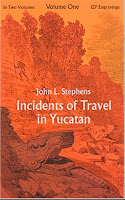On that website it reads: “This is the place if you want to learn about Book of Mormon geography. The Mesoamerican model originated with a faulty premise and will therefore never achieve consensus. A North American setting fits the text. This blog looks at the origins and scholarship behind the Mesoamerican theory.”
This article evidently appeared on Thursday May 26, 2016, and was sent to us the same day by Adam W. who sends us a lot of information from that website.
Under the title of “Simplicity,” the website posts: “The simplest explanation is usually the best, a principle often described as Occam’s Razor, [which states} "Among competing hypotheses, the one with the fewest assumptions should be selected."
[My comment: By way of explanation, William of Ockham, (Latinized Gulielmus Occamus), 1287-1347, was an English Franciscan friar and scholastic philosopher and theologian who is believed to have been born in Ockham a small village in Surrey. He is considered to be one of the major figures of medieval thought and was at the center of the major intellectual and political controversies of the fourteenth century. He is commonly known for his Occam’s razor, the methodological principle that bears his name, and also produced significant works on logics, physics, and theology]
Continuing with the post:
On the topic of Book of Mormon geography, which setting requires the fewest assumptions? Which explanation is the simplest?
The North American setting has one assumption.
1. Joseph Smith and Oliver Cowdery knew that the Hill Cumorah in New York was the place where the Nephite and Jaredite civilizations were destroyed. Everything directly attributable to them is consistent with that setting. Contrary ideas are not directly attributable to them; therefore, these contrary ideas were produced by other people who didn't know what Joseph and Oliver knew.
The Mesoamerican setting relies on a series of assumptions:
1. Joseph Smith didn't know where the Book of Mormon events took place.
2. Oliver Cowdery (or another unknown person) at some unspecified date started a folk tradition that Cumorah was in New York, based on an incorrect assumption.
3. Joseph misled his wife Emma when he wrote to her about crossing the plains of the Nephites after he'd crossed Ohio, Indiana, and Illinois.
4. Oliver memorialized the incorrect folk tradition in Letter VII in 1835.
5. Joseph, for unexplained reasons, passively adopted Oliver's speculation and had it widely published.
6. Joseph, who wrote very little himself, nevertheless wrote a series of articles in the Times and Seasons about Central America that he left anonymous for unknown reasons.
7. David Whitmer, late in life, conflated his own specific memory of the first time he heard the word "Cumorah" with Oliver's folk tradition.
Which set of assumptions makes the most sense to you?
[My comment: Not all of the above are facts. Some are opinions, such as we do not have any signed statement by Joseph Smith that he wrote the articles mentioned in #6 above. That they were unsigned cannot be then assigned to Joseph that he actually wrote them or even read them though he was the editor at the time. Nor do we know why Joseph “passively adopted” Oliver’s speculation. Again, this is an opinion not a fact, with at least one other rationale, such as Joseph was interested in using Oliver’s extensive writing on the Hill Cumorah since it covered in detail Joseph finding the plates there, which was the issue of his interest]
Continuing with the post:
Here are some relevant quotations about simplicity.
• “If you can't explain it to a six year old, you don't understand it yourself.” ― Albert Einstein
• To which Groucho Marx replied:
“A child of five could understand this. Send someone to fetch a child of five.” ― Groucho Marx
• “Truth is ever to be found in the simplicity, and not in the multiplicity and confusion of things.” ― Isaac Newton
• Why did they believe? Because they saw miracles. Things one man took as chance, a man of faith took as a sign. A loved one recovering from disease, a fortunate business deal, a chance meeting with a long lost friend. It wasn't the grand doctrines or the sweeping ideals that seemed to make believers out of men. It was the simple magic in the world around them.” ― Brandon Sanderson, The Hero of Ages
• “People who pride themselves on their "complexity" and deride others for being "simplistic" should realize that the truth is often not very complicated. What gets complex is evading the truth.” ― Thomas Sowell, Barbarians inside the Gates and Other Controversial Essays
• “..things are never as complicated as they seem. It is only our arrogance that prompts us to find unnecessarily complicated answers to simple problems.” ― Muhammad Yunus, Banker to the Poor: Micro-Lending and the Battle Against World Poverty
• “I am not a genius, I am just curious. I ask many questions. and when the answer is simple, then God is answering.” ― Albert Einstein
[End of article]
Now that the Great Lakes theorist has made his point, I have just one question.
“Where are the mountains whose height is great?”
It is a simple
question, one my six year old grand daughter asked, after reading to her the
statement in Helaman 14:23 as we drove through the flat lands of Great Lakes of
western New York—a very flat land all through the lakes area and New York until
we reached the Pennsylvania border on our way to Philadelphia from Niagara
Falls—at which time she got a big laugh out of the term “Endless Mountains” in
northeastern Pennsylvania that are not mountains at all, but just some rolling
hills (2693 elevation, North Knob Elk Mountain—most of the Endless Mountains,
however, are between 1000 and 2000 feet). My wife, who had grown up in her
early years in Parowan, Utah, in the Rocky Mountains, where she took numerous
trips to Brian Head ski resort, is 9800-feet.Show me the mountains whose height is great. If we are going to go with Occam’s Razor, then that is about as simple as it gets.
Lest we forget, Samual the Lamanite, called by the Lord to speak to the inhabitants of the City of Zarahemla what he (the Lord) put in his (Samuel's) heart to tell them, said regarding the time of the Crucifixion, “And behold, there shall be great tempests, and there shall be many mountains laid low, like unto a valley, and there shall be many places which are now called valleys which shall become mountains, whose height is great” (Helaman 14:23). And to make sure we understood him, he added, “And behold, thus hath the angel spoken unto me; for he said unto me…that many shall see greater things than these, to the intent that they might believe that these signs and these wonders should come to pass upon all the face of this land, to the intent that there should be no cause for unbelief among the children of men” (Helaman 14:26,28).
Now go ahead. Apply Occam’s Razor. Which is simpler, that Andean Peru had mountains “whose height is great,” Mesoamerica, which has mountains that are medium height in greatness, and the Great Lakes area has no mountains—no, not one.
Choose which one is the simpler answer.
Go ahead, apply Occam’s Razor.
We’ll wait.































